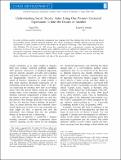Understanding Social Display Rules: Using One Person’s Emotional Expressions to Infer the Desires of Another
Author(s)
Wu, Yang; Schulz, Laura E
DownloadPublished version (649.0Kb)
Publisher with Creative Commons License
Publisher with Creative Commons License
Creative Commons Attribution
Terms of use
Metadata
Show full item recordAbstract
© 2019 The Authors Child Development published by Wiley Periodicals, Inc. on behalf of Society for Research in Child Development In social contexts, people’s emotional expressions may disguise their true feelings but still be revealing about the probable desires of their intended audience. This study investigates whether children can use emotional expressions in social contexts to recover the desires of the person observing, rather than displaying the emotion. Children (7.0–10.9 years, N = 211 across five experiments) saw a protagonist express one emotional expression in front of her social partner, and a different expression behind her partner’s back. Although the protagonist expressed contradictory emotions (and the partner expressed none), even 7-year-olds inferred both the protagonist’s and social partner’s desires. These results suggest that children can recover not only the desire of the person displaying emotion but also of the person observing it.
Date issued
2019Department
Massachusetts Institute of Technology. Department of Brain and Cognitive Sciences; Center for Brains, Minds, and MachinesJournal
Child Development
Publisher
Wiley